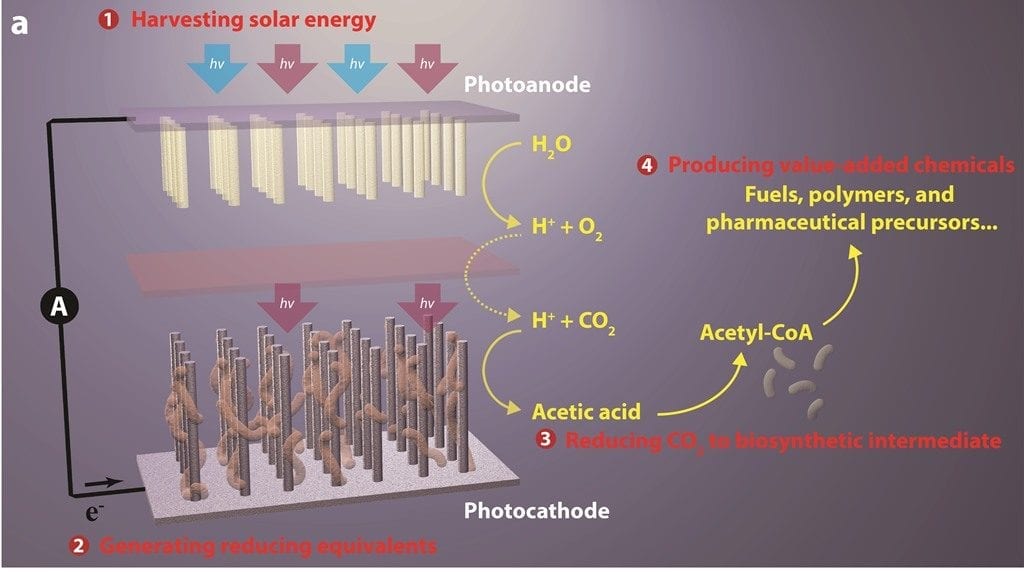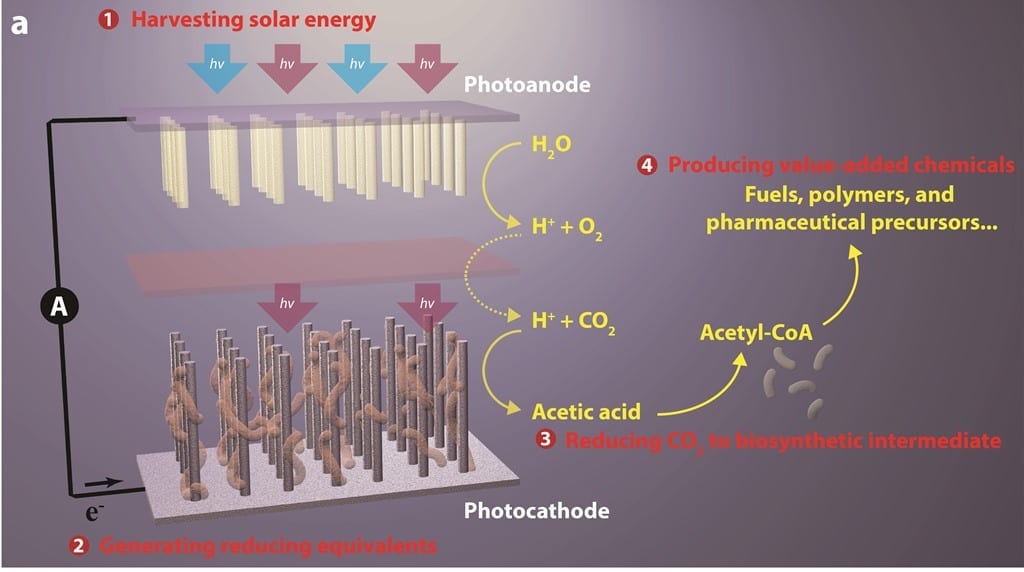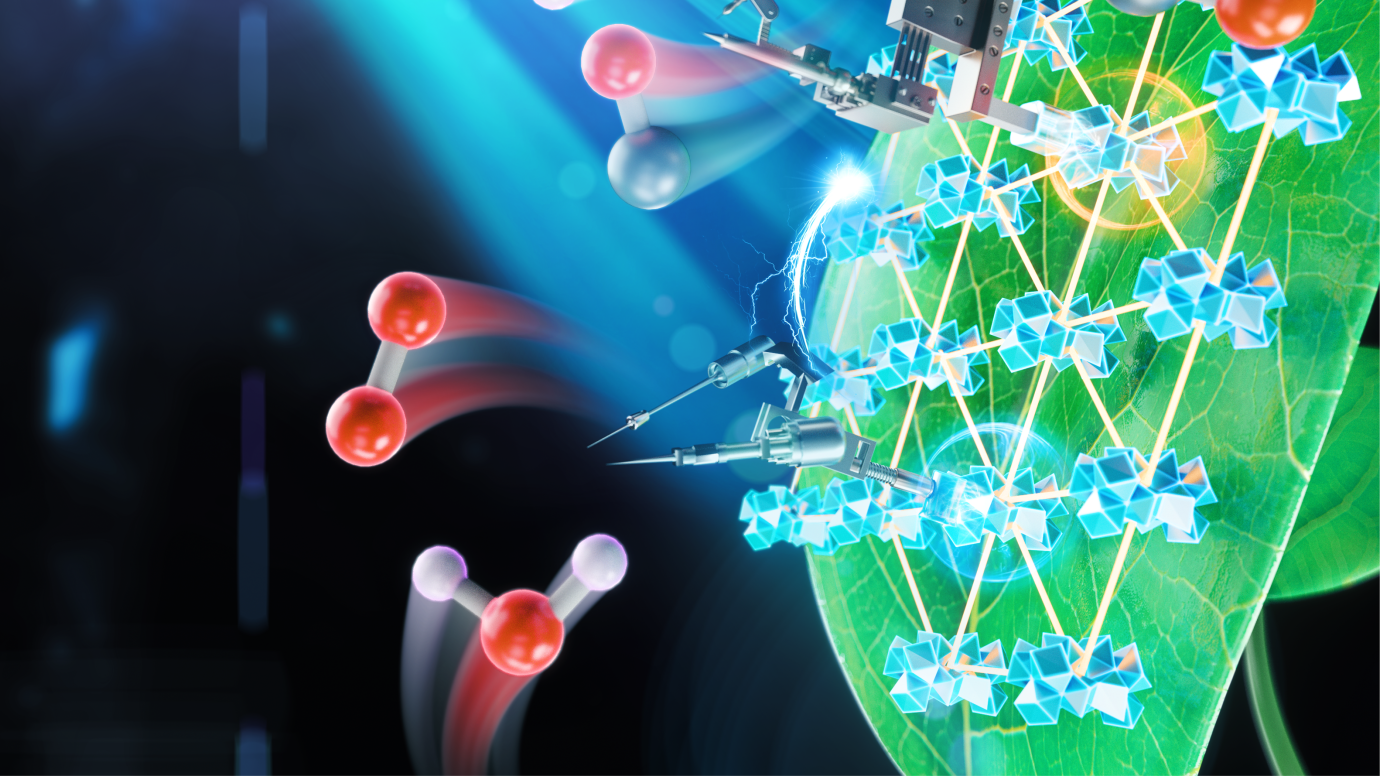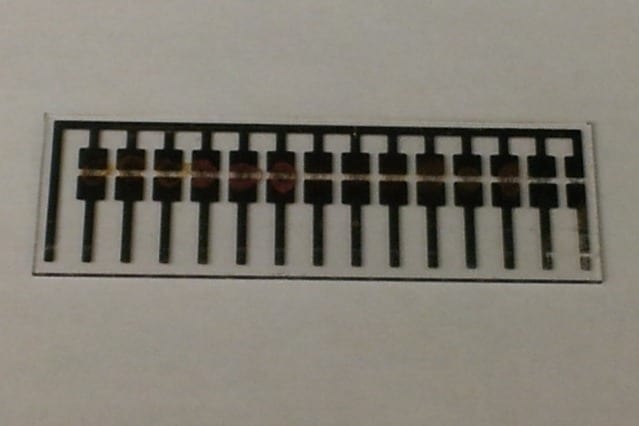
Berkeley Lab Researchers Perform Solar-powered Green Chemistry with Captured CO2
A potentially game-changing breakthrough in artificial photosynthesis has been achieved with the development of a system that can capture carbon dioxide emissions before they are vented into the atmosphere and then, powered by solar energy, convert that carbon dioxide into valuable chemical products, including biodegradable plastics, pharmaceutical drugs and even liquid fuels.
Scientists with the U.S. Department of Energy (DOE)’s Lawrence Berkeley National Laboratory (Berkeley Lab) and the University of California (UC) Berkeley have created a hybrid system of semiconducting nanowires and bacteria that mimics the natural photosynthetic process by which plants use the energy in sunlight to synthesize carbohydrates from carbon dioxide and water. However, this new artificial photosynthetic system synthesizes the combination of carbon dioxide and water into acetate, the most common building block today for biosynthesis.
“We believe our system is a revolutionary leap forward in the field of artificial photosynthesis,” says Peidong Yang, a chemist with Berkeley Lab’s Materials Sciences Division and one of the leaders of this study. “Our system has the potential to fundamentally change the chemical and oil industry in that we can produce chemicals and fuels in a totally renewable way, rather than extracting them from deep below the ground.”
Yang, who also holds appointments with UC Berkeley and the Kavli Energy NanoSciences Institute (Kavli-ENSI) at Berkeley, is one of three corresponding authors of a paper describing this research in the journal Nano Letters. The paper is titled “Nanowire-bacteria hybrids for unassisted solar carbon dioxide fixation to value-added chemicals.” The other corresponding authors and leaders of this research are chemists Christopher Chang and Michelle Chang. Both also hold joint appointments with Berkeley Lab and UC Berkeley. In addition, Chris Chang is a Howard Hughes Medical Institute (HHMI) investigator. (See below for a full list of the paper’s authors.)
The more carbon dioxide that is released into the atmosphere the warmer the atmosphere becomes. Atmospheric carbon dioxide is now at its highest level in at least three million years, primarily as a result of the burning of fossil fuels. Yet fossil fuels, especially coal, will remain a significant source of energy to meet human needs for the foreseeable future. Technologies for sequestering carbon before it escapes into the atmosphere are being pursued but all require the captured carbon to be stored, a requirement that comes with its own environmental challenges.
The artificial photosynthetic technique developed by the Berkeley researchers solves the storage problem by putting the captured carbon dioxide to good use.
“In natural photosynthesis, leaves harvest solar energy and carbon dioxide is reduced and combined with water for the synthesis of molecular products that form biomass,” says Chris Chang, an expert in catalysts for carbon-neutral energy conversions. “In our system, nanowires harvest solar energy and deliver electrons to bacteria, where carbon dioxide is reduced and combined with water for the synthesis of a variety of targeted, value-added chemical products.”
By combining biocompatible light-capturing nanowire arrays with select bacterial populations, the new artificial photosynthesis system offers a win/win situation for the environment: solar-powered green chemistry using sequestered carbon dioxide.
Read more: Major Advance in Artificial Photosynthesis Poses Win/Win for the Environment
The Latest on: Artificial Photosynthesis
[google_news title=”” keyword=”Artificial Photosynthesis” num_posts=”10″ blurb_length=”0″ show_thumb=”left”]
via Google News
The Latest on: Artificial Photosynthesis
- JinkoSolar gets grant for improved solar cell structure for enhanced photoelectric conversionon May 6, 2024 at 3:19 am
Revolutionize solar cell efficiency with JinkoSolar's patented design featuring pyramid structures and precise doping concentrations. Learn more about this innovative technology now!
- JinkoSolar gets grant for photovoltaic cell with metal and non-metal pattern regionson May 6, 2024 at 2:30 am
Discover the groundbreaking patent by JinkoSolar for a novel photovoltaic cell design with pyramid structures, tunneling layers, and doped conductive layers to enhance solar energy conversion ...
- Toward artificial leaves that float on water, bubbling fuelon May 2, 2024 at 2:14 pm
Researchers have now made such an artificial leaf device using an organic photovoltaic (OPV) material. Depending on the catalyst used, the device either splits water to make hydrogen fuel or splits ...
- The 8 Best Grow Lights for Countertop Herbs, Small Gardens, and Helping Indoor Plants Thriveon April 30, 2024 at 2:33 pm
Narrow spectrum lights are noted for serious gardeners and plant nerds who need to support different stages of development. Blue-light spectrum (450-490 nm) grow lights are used for early-stage growth ...
- The Advantages of Going Solaron April 29, 2024 at 9:33 am
This article explores the numerous advantages of adopting solar energy, both from an environmental standpoint and its capacity to influence economic and personal development.
- Is Artificial Photosynthesis the Next Source of Renewable Energy?on February 19, 2024 at 9:09 pm
Photosynthesis is the process by which plants convert sunlight into energy, inspiring sustainable energy solutions. Artificial photosynthesis aims to imitate the process of photosynthesis to ...
- The other half of the equationon October 20, 2023 at 12:43 am
Artificial photosynthesis — splitting water with light — is an attractive way to make hydrogen, but what happens to the oxygen? A catalyst that aids in the efficient production of gaseous ...
- Artificial Photosynthesis: A Game Changer for Clean Energyon September 25, 2023 at 5:00 pm
that brings us a step closer to the day carbon dioxide could be used as a resource.
- Artificial photosynthesis machines invented to create oxygen in space for astronautson June 13, 2023 at 11:15 am
In a game-changing technological breakthrough, scientists are creating artificial photosynthesis devices that astronauts will use on future space missions. On our lush and abundant planet Earth ...
- Artificial Photosynthesis—Making Fuels Directly from Sunlighton May 13, 2022 at 5:40 pm
Nathan Lewis will present about the discovery and development of materials and a system architecture for the direct production of fuels from sunlight. The membrane-embedded microwire array approach is ...
via Bing News











